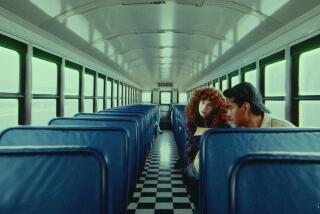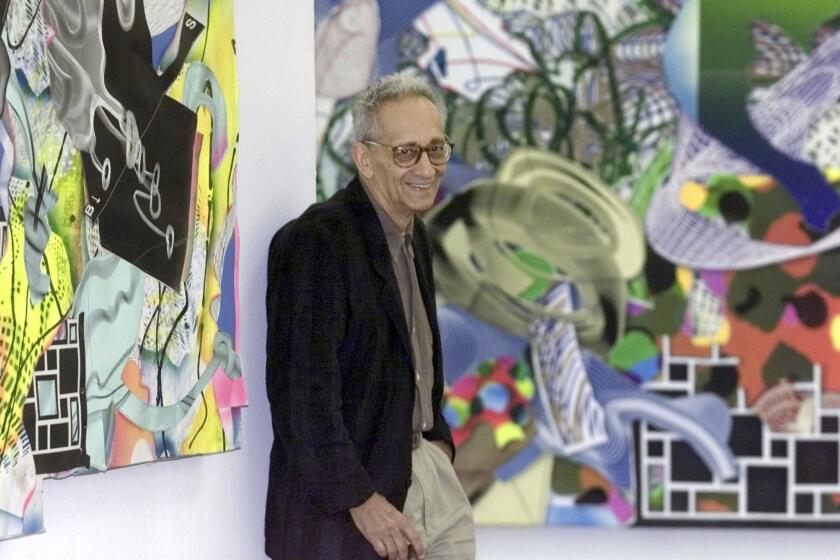Bronzes as brawny and ‘black sheep’ as their collector
Peter Marino, a born maverick, is obsessed with bronzes. Certain kinds of bronzes.
“I don’t collect wimpy ones,” says the New York architect and designer. “I don’t have people looking gaga at each other or anything sort of sweet or saccharine. I like best my Samson crushing the Philistine with the jawbone. This is quite powerful stuff. At the same time, I find it incredibly beautiful.”
Such dynamic and sensuous scenes abound in the new exhibition “Beauty and Power: Renaissance and Baroque Bronzes From the Peter Marino Collection.” The show, which opened at the Huntington Library, Art Collections, and Botanical Gardens in San Marino this weekend, reflects Marino’s affinity for sculpture’s “movement and muscularity” as well as his desire to listen to his heart rather than the conventional wisdom when it comes to collecting.
At 60, Marino is a celebrated designer of luxury spaces, including retail temples for Chanel and Louis Vuitton and grand homes and hotel suites. A collector whose tastes run from French porcelain to De Kooning and Twombly, he has an eclectic passion for art that is evident in his interiors, exteriors and museum installations. He often turns heads by wearing leather biker gear whether he’s doing business in Qatar or partying in Beverly Hills.
Despite his very public life, Marino has kept his penchant for small bronzes private for more than two decades. “My collection has always been very, very discreet,” he says on the phone from Manhattan. “Very few people knew about this.”
“Beauty and Power,” which debuted at the Wallace Collection in London in April, offers what Catherine Hess, the Huntington’s chief curator of European art, calls “the rare opportunity to see works, most of which have not been seen, except at the Wallace, because they’ve long been in private hands.” Hess, who organized the San Marino exhibition, says the 28 statuettes and two vases “introduce the public to a type of object and to important artists they perhaps didn’t know before.”
Some single-collector exhibitions have raised questions lately. The Huntington says “Beauty and Power” stands on its own merits.
“While relatively small, the collection is of outstanding quality,” says Jeremy Warren, the exhibition’s curator and the collections and academic director at the Wallace, a museum known for its fine and decorative arts. “With its focus on the Italian and French Baroque, it is certainly different from many traditional bronze collections, which are built around the Italian Renaissance,” and it is “full of surprises, with objects that just breathe sensuality.”
Indeed, many pieces depict rippling bodies caught in moments poignant or theatrical, inspired by classical myths and biblical tales.
Bronze statuettes were popular in ancient times and again during the Renaissance and beyond. Since the Medici, bronze figures associated with antiquity have attracted what Hess calls “a long line of wealthy and erudite collectors” with their technical artistry and evocative subjects. A relatively small number of people pursue such works today, in part because fewer objects are available outside museums, attributions are harder to pin down and serious pieces cost hundreds of thousands to millions of dollars.
Marino finds such challenges intriguing. “It’s a game of connoisseurship, which I kind of particularly like.”
The native New Yorker began collecting art three decades ago, his interest whetted by people including Andy Warhol, who was among his first clients. He began to collect bronzes a few years later, but has avoided buying in his own name and has used other methods to keep his acquisitions quiet. Marino says he “primarily purchases based on aesthetic qualities. If I like a piece, I do my research, my homework, and I get professional opinions, and then I buy.”
Over time, he acknowledges, his reactions may change. “That’s why it’s like looking at a lover. Sometimes, you look at one 12 or 13 years later and say. ‘What did I see?’”
New insights also come from new research and the practice of comparing casts. For the exhibition, Warren wrote an extensive catalogue and so, says Marino, “the great fun for me in finally exposing these bronzes was hearing about different ones. Sometimes, my own opinion got profoundly shaken, or sometimes profoundly confirmed.”
“As you see better things,” he adds, “sometimes you are disappointed. Other times, you see your own cast [compared] against what a museum has and you go, ‘Wow, mine is so much better.’” Marino doesn’t mind when he holds the contrarian view. “In my work, if I know 90% of the world likes something, then I am sure to loathe it. I am interested in the black sheep, and this is the perfect black sheep collecting vehicle.”
Rather than black sheep, Hess sees Marino’s pieces as “selections by someone with a very good eye.” As examples she cites “Samson and the Philistine,” which has been attributed to the Florentine Baccio Bandinelli, and Corneille van Cleve’s “Bacchus and Ariadne.” Besides these, Marino says, his other favorites include Giovanni Battista Foggini’s “Apollo and Marsyas” and “David Triumphant Over Goliath” and Michel Anguier’s “Ceres.”
Warren says he learned of the collection a few years ago when a London art dealer introduced him to Marino’s European operations director, who asked whether he would be interested in writing a catalog of the collection. “I suggested that if I were to do the catalog, why not exhibit this fantastic collection, so it could be seen by a wider public.”
When Warren visited Marino’s apartment, his host greeted him in full biker regalia. (A motorcycle buff, Marino says he has routinely worn riding gear since he was 50.) Marino recalls that when he led Warren to the salon where he keeps his bronzes, “his jaw literally dropped.”
“It was an extraordinary surprise,” says Warren. “I did know something about Peter Marino beforehand, but — like almost all current bronze specialists — had no idea that he had built such a spectacular collection.” He also was impressed with the way the bronzes were displayed, “together with American Abstract Expressionist masterpieces and severe neo-classical furniture.”
“While he tends to present himself in one way to the wider world, I think you see the real and more sensitive man in his collections, with very fine objects that are carefully selected and acquired with a view to how they will impact on the whole collection.”
At first, Marino was reluctant to exhibit his bronzes. “The fun for me was collecting them secretly... I do this because I love it. Sometimes, you don’t want to show the whole world what you love so much.” He finally agreed. The idea of “making a record” of his objects was appealing, as was Warren’s research.
When “Beauty and Power” opened in London, the Independent declared “the Wallace’s exhibition punches above its tiny weight.” The Burlington Magazine called it “a triumph.”
The Huntington show, which will include five of the institution’s pieces, will close Jan. 24. The exhibition then moves to the Minneapolis Institute of Arts.
Even though his secret is out, Marino is continuing to collect bronzes. “In fact, I just purchased an extraordinary masterpiece by Barthelemy Prieur two weeks ago,” he says. “Stopping isn’t in my blood.”
calendar@latimes.com
More to Read
The biggest entertainment stories
Get our big stories about Hollywood, film, television, music, arts, culture and more right in your inbox as soon as they publish.
You may occasionally receive promotional content from the Los Angeles Times.






